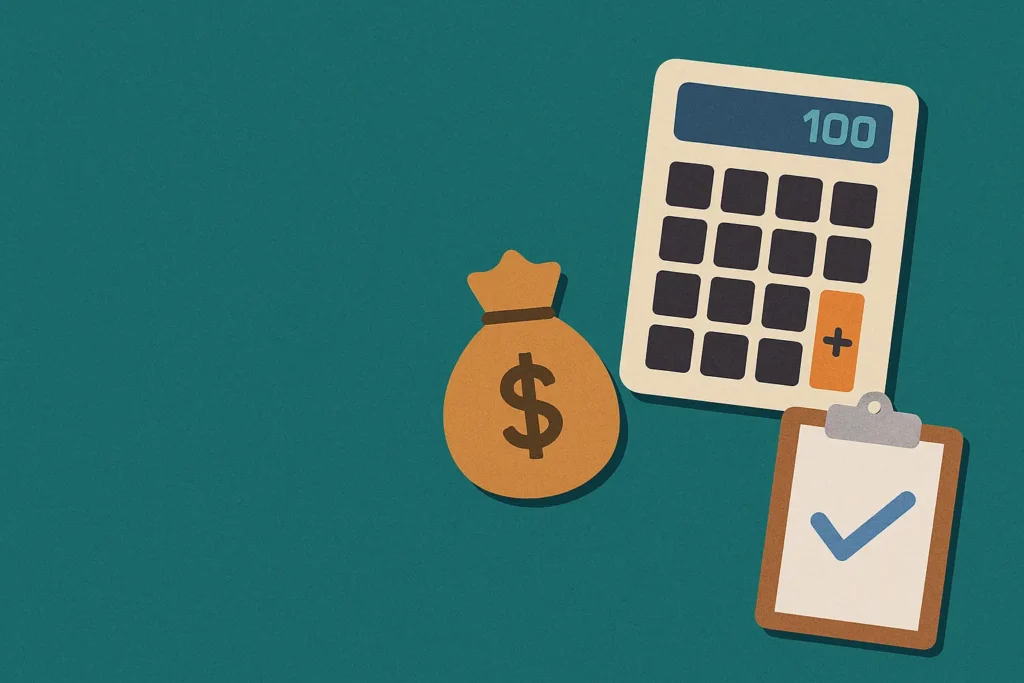Let’s be honest — pricing your freelance services can feel like a guessing game. Too low, and you’re stuck in the underpaid hustle. Too high, and you’re worried about scaring clients away.
So how do you actually figure out the right number?
If you’re a freelancer in Nigeria or Ghana, the stakes are even higher. You’re not just navigating local expectations — you’re competing globally.
This blog breaks down what really matters when pricing your services, how to avoid common mistakes, and how to calculate a rate that actually works for your life — not just the market.
Pro tip: Want to skip the guesswork? Use the Freelancer Rate Estimator on Paycape — it’s free, simple, and tailored for African freelancers.
Why Is Pricing So Confusing?
Pricing your freelance services is one of those things that sounds simple—until you actually have to do it.
Most people either look at what others are charging and copy it, or they ask ChatGPT (like you just did). Others take the “let me charge something small so they’ll say yes” route. And that’s exactly how many skilled freelancers end up broke, overworked, and underpaid.
In Nigeria and Ghana especially, it gets more complicated. You’re navigating not just local pricing expectations, but global competition. You might have a client from Lagos who wants a website for ₦20,000, and another from London willing to pay ₦500,000 for the same thing. How do you decide?
The truth is: there’s no magic number that works for everyone. Your pricing has to match your skill, workload, lifestyle, expenses, and client type.
But here’s the catch — most freelancers don’t take those things into account. They wing it. And that’s where the confusion (and frustration) begins.
This guide is here to help you cut through that confusion. No fluff, no “charge your worth” without context. Just a practical way to understand what should influence your pricing — and how to land on a number that works for you and your client.
What Should Actually Influence Your Rates?
If you’re still charging clients based on what you think they can afford, you’re already leaving money on the table. The truth is, your freelance rate should have almost nothing to do with what others are charging and everything to do with your own goals, cost of doing business, and the value you bring to the table.
Here are five factors that should shape how you price your freelance services:
1. Your Skill Level
Are you just starting out, or have you spent years sharpening your craft? If you’ve got results, testimonials, or case studies to back up your work, that adds weight to your price. On the flip side, beginners can charge less temporarily while building confidence — but even then, never price yourself below survival.
2. The Type of Service You Offer
Not all services are equal. Writing a 500-word article is not the same as writing SEO landing pages for a product launch. Designing a logo is not the same as creating a full brand identity. The more specialized or high-impact your service is, the more you should charge.
3. Client Type and Location
Serving a small local business? Your rate may differ from what you’d quote an international client with a higher budget. It’s not about inflating your price — it’s about aligning your rate with the scope, value, and expectations of the client.
4. Your Income Goals
This is where a lot of freelancers miss it. You’re not just pricing a service — you’re building a business. Ask yourself: How much do I want or need to earn per month? How many hours can I realistically work?
Your pricing needs to support your life — not just fund your next data bundle.
5. Your Expenses
Subscriptions, tools, electricity, internet, workspace, transportation — all these costs are part of your business. If you’re not including them in your pricing, you’re already operating at a loss.
The key takeaway?
Stop guessing. Start calculating. That’s how you avoid resentment and burnout — and how you start building a career that pays you what your time is truly worth.
Hourly vs Project Pricing — Which One Wins?
One of the first questions many freelancers ask is: Should I charge per hour or per project?
The answer? It depends on the kind of work you do — and how much control you want over your time and income.
Let’s break it down:
Hourly Pricing: Pay Me for My Time
Hourly rates are simple. You set a number (say ₦5,000/hour or GH₵60/hour), track your hours, and get paid based on how long the work takes.
It works well for:
- Ongoing work with changing scope
- Virtual assistance, admin, or customer support
- Projects where time is the main deliverable
But here’s the downside:
If you’re fast and efficient, you earn less. And if clients start micromanaging your hours, it can feel like a 9-5 job in disguise.
Project-Based Pricing: Pay Me for Results
Here, you charge a fixed fee for a defined deliverable — like a logo design, a landing page, or a social media content pack.
This works great for:
- Deliverables with a clear beginning and end
- Experienced freelancers who can estimate time accurately
- Clients who care about outcomes, not how long you spend
The advantage? You can earn more by working efficiently. Your time isn’t capped — your value is what’s rewarded.
Which One Is Better?
There’s no winner. Smart freelancers use both.
For example:
- Use hourly rates for consultations, retainers, or tasks with unclear scope.
- Use project rates for defined jobs where you control the process and timeline.
The real trick is knowing when to use each — and communicating that clearly in your proposals and contracts.
Sample Freelance Rates in Nigeria & Ghana (2025)
One of the easiest ways to gain confidence in your pricing is to see what other freelancers are charging. But take this with a grain of salt — rates vary based on skill, experience, niche, and client type.
Below are current freelance rate ranges based on reports from platforms like ModernGhana, African Freelancers, Truehost, and BusinessDay. Use these figures to guide your pricing, not to copy blindly.
Average Freelance Rate Ranges
| Service | Nigeria (₦) | Ghana (GH₵) |
|---|---|---|
| Blog Writing | ₦10,000 – ₦30,000/article | GH₵150 – GH₵400/article |
| Logo Design | ₦50,000 – ₦300,000/project | GH₵500 – GH₵2,500/project |
| Web Development | ₦70,000 – ₦5,000,000 | GH₵1,000 – GH₵10,000+ |
| Social Media Mgmt | ₦40,000 – ₦150,000/month | GH₵600 – GH₵2,500/month |
| Copywriting | ₦20,000 – ₦100,000/project | GH₵300 – GH₵1,500/project |
| Video Editing | ₦50,000 – ₦250,000/project | GH₵700 – GH₵2,200/project |
| Virtual Assistance | ₦3,000 – ₦6,000/hour | GH₵35 – GH₵65/hour |
What This Means for You
These aren’t fixed rates — they’re ranges. What you charge depends on:
- Your experience and skill level
- The value and complexity of the project
- Who your client is (local vs international)
- Your monthly income and cost of living
For example, a Nigerian designer might charge ₦80,000 for a logo for a small business, but quote ₦300,000+ for a corporate brand identity. Likewise, a Ghanaian content writer charging GH₵200 per article locally might ask for GH₵500+ when writing for a fintech company abroad.
You don’t have to charge at the top of the range. You just need to charge based on logic — not fear.
And if you’re unsure where you fall within these numbers, don’t guess — calculate. That’s what we’ll cover in the next section.
And if you’re still unsure where you fall in that range? Keep reading!
Want to Stop Guessing? Use This Free Rate Calculator
If you’re still unsure what to charge, you’re not alone. Most freelancers either guess, copy others, or wait for the client to suggest a price. That’s a risky way to run a business — and it almost always leads to undercharging.
Here’s a better approach:
Reverse-engineer your rates based on your goals.
Think about it:
- How much do you want to earn per month?
- How many hours can you realistically work each week?
- What do your monthly expenses look like?
- How many projects can you deliver without burning out?
When you answer those questions, pricing stops being emotional — it becomes math.
To make that easier, we built something for you:
🎯 Use the Paycape Freelancer Rate Calculator
Just plug in your monthly income goal, expenses, and working hours.
In seconds, you’ll get a recommended hourly and project-based rate that reflects your reality.
It’s simple. It’s free. No sign-up required.
Whether you’re in Lagos, Accra, Kumasi, Abuja, or anywhere in between — this tool helps you price your services based on logic, not guesswork.
If you’ve ever asked yourself “Am I charging too little or too much?”, this is how you find out.
Pricing Mistakes That Keep Freelancers Broke
It’s not just about what you charge — it’s also about what you don’t realize you’re doing wrong. Even talented freelancers fall into these traps, and the result is almost always the same: stress, resentment, and financial struggle.
Here are the most common mistakes that keep freelancers stuck:
1. Charging Based on What You Think a Client Can Afford
When a client says, “My budget is tight,” many freelancers instinctively drop their rates. But here’s the truth: a client’s budget is not your responsibility. If you keep adjusting your pricing to “help” every low-budget client, you’ll always be broke — no matter how hard you work.
2. Quoting Without Clarity
Jumping into pricing before you fully understand the scope is a recipe for disaster. Always ask questions:
- How many deliverables?
- How many revisions?
- What’s the timeline?
- Will this require ongoing updates or support?
The clearer you are upfront, the less likely you’ll end up working double for the same pay.
3. Never Increasing Your Rates
If your pricing hasn’t changed in over a year — even though your skills, experience, and results have — you’re leaving money on the table. Regularly evaluate and raise your rates, especially with new clients or larger projects.
4. Not Including Revision Limits or Scope Boundaries
You charged ₦40,000 for a design, and now you’re on revision number seven. This happens when you don’t set limits. Every proposal should include a clear cap on revisions and specify what’s included (and what’s not).
5. Undervaluing “Small” Tasks
Even if something takes you 20 minutes, it still took years to get good enough to do it that fast. Quick doesn’t mean cheap. Always charge for the value, not just the time.
The fix to all of this?
Stop treating your freelance work like a side gig, and start managing it like a business. That includes setting clear boundaries, revisiting your pricing regularly, and using tools that help you stay objective.
What to Say When Clients Push Back on Price
You’ve done the math. You’ve set a rate that reflects your skill, your time, and your business expenses. You finally send the quote… and then comes the reply:
“That’s too expensive. Can you do it for less?”
This moment can shake even the most experienced freelancers. But here’s what you need to remember: if you don’t value your work, no one else will.
Instead of rushing to lower your price, keep it simple and confident:
“I totally understand. My rates are based on the time, quality, and strategy I bring to each project. If this doesn’t align with your budget right now, no pressure at all — maybe we can work together in the future.”
That one sentence does three things:
- It reinforces your value
- It leaves the door open without desperation
- It filters out low-intent clients
In some cases, you can offer a reduced-scope version of the service — fewer revisions, a simpler deliverable, or a stretched-out timeline. But never discount your rate just to “win” a client who likely won’t respect your process.
If you’re still learning how to position your services — or even deciding which services to offer — you’re not alone. Many freelancers start by picking up digital services they can offer online, like virtual assistance, graphic design, or content writing.
Others dive into freelance-friendly digital skills that are in high demand globally, including SEO, video editing, and email marketing.
And for those with a strong voice or creative angle, content creation has become a powerful income stream — especially when paired with brand strategy or community building.
The point is: once you know the value of what you’re offering, it gets much easier to defend your pricing without flinching. And the right clients — the ones who respect your work — will rarely ask for discounts in the first place.
Don’t Just Work — Work Smart
If there’s one thing to take away from this guide, it’s this:
Your freelance pricing should not be based on fear, vibes, or guesses.
It should be rooted in clarity — the kind that comes from understanding your skills, your expenses, your goals, and your worth.
Underselling yourself might get you a few quick wins, but it’s not sustainable. It leads to burnout, bitterness, and a business that barely breaks even.
Start treating your freelance work like the business it is.
Calculate your rates intentionally. Protect your time. Build a system that works for you, not just your clients.
And when you need help figuring out what that system looks like?
Use tools like our Freelancer Rate Estimator — built specifically for freelancers in Nigeria, Ghana, and across Africa who want to stop guessing and start charging right.
Your skills deserve to be paid for. Your time deserves structure. And your income should support the life you’re trying to build.
So set your rate — and stand on it.
FAQs: Freelancer Pricing in Nigeria & Ghana
Freelance rates in Nigeria vary by industry and experience. On average, writers charge between ₦10,000 to ₦100,000 per article, designers charge ₦15,000 to ₦80,000 for logos, and developers can charge anywhere from ₦70,000 to over ₦300,000 per project. It’s important to calculate your rate based on your expenses, skill level, and goals — not just industry averages.
Beginner freelancers in Ghana may start at GH₵100–GH₵200 per project depending on the service. However, rather than underpricing out of fear, use a tool like Paycape’s Freelancer Rate Estimator to calculate a rate that covers your time, costs, and income goals.
It depends on the job. Hourly rates work well for ongoing or admin-based work, while project-based pricing is better for fixed deliverables like web design or branding. Many freelancers use a combination of both, depending on the scope and client preference.
– You’re likely undercharging if:
– You feel burnt out despite working a lot
– You’re not covering your expenses
– Clients don’t hesitate to say yes to your rate
If this sounds familiar, it’s time to revisit your pricing strategy.
The best way is to:
– Improve your positioning (portfolio, testimonials, clarity)
– Communicate your value clearly
– Raise your rates gradually
Many quality clients expect rate increases over time — especially if you deliver strong results.




